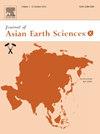Provenance and uranium source of the lower cretaceous sedimentary rocks in Northern Sichuan Basin: evidence from sedimentary facies analysis and detrital zircon U-Pb geochronology
IF 2.3
Q3 GEOSCIENCES, MULTIDISCIPLINARY
引用次数: 0
Abstract
In this paper, we present results of sedimentary facies analysis and U-Pb dating of detrital zircons from the Lower Cretaceous uranium-bearing sandstones in northern Sichuan Basin, to investigate the influence of provenance and sedimentation process on the temporal and spatial distribution of uranium-bearing sandstones. The results show that there are four major zircon U-Pb age populations that cluster at 2800–2200 Ma (group 1), 2200–1600 Ma (group 2), 1600–538 Ma (group 3), and 538–145 Ma (group 4), respectively. The age data, combined with regional tectonic events, indicate that zircons of group 1, group 2 and group 3 in the western part of the Sichuan basin were mainly derived from the Bikou and Songpan-Ganzi terranes, and the varieties of group 4 were mainly originated from the Longmenshan thrust belt. Whereas zircons of group 1, group 2 and group 3 in the eastern part of the Sichuan basin were primarily sourced from the South Qinling Belt and the Bikou terrane, and those of group 4 were likely affiliated with the Hannan Micangshan massif and Dabashan thrust belt. The Paleozoic low-grade metamorphic rocks and Mesozoic sedimentary rocks and minor intermediate-acidic magmatic and volcanic rocks represented by group 4 zircons are considered as the primary source for uranium mineralization in the Lower Cretaceous sandstones. The Neoarchean to Proterozoic metamorphic rocks and plutonic and volcanic rocks, as revealed from the group 1, group 2 and group 3 zircons also contributed partially to the uranium sources.
川北下白垩统沉积岩物源与铀源:沉积相分析与碎屑锆石U-Pb年代学证据
本文介绍了川北地区下白垩统含铀砂岩碎屑锆石的沉积相分析和U-Pb定年结果,探讨了物源和沉积过程对含铀砂岩时空分布的影响。结果表明,锆石U-Pb年龄群主要分布在2800 ~ 2200 Ma(第1组)、2200 ~ 1600 Ma(第2组)、1600 ~ 538 Ma(第3组)和538 ~ 145 Ma(第4组)。年龄资料结合区域构造事件表明,四川盆地西部1、2、3组锆石主要来源于碧口和松潘-甘孜地体,4组锆石品种主要来源于龙门山冲断带。四川盆地东部第1、2、3组锆石主要来自南秦岭带和碧口地体,第4组锆石可能来自汉南米沧山地块和大巴山冲断带。下白垩统砂岩中,以第4组锆石为代表的古生代低变质岩和中生代沉积岩以及少量中酸性岩浆岩和火山岩是铀矿化的主要来源。1、2、3群锆石显示,新太古代至元古代的变质岩、深成岩和火山岩对铀源也有部分贡献。
本文章由计算机程序翻译,如有差异,请以英文原文为准。
求助全文
约1分钟内获得全文
求助全文
来源期刊

Journal of Asian Earth Sciences: X
Earth and Planetary Sciences-Earth-Surface Processes
CiteScore
3.40
自引率
0.00%
发文量
53
审稿时长
28 weeks
 求助内容:
求助内容: 应助结果提醒方式:
应助结果提醒方式:


